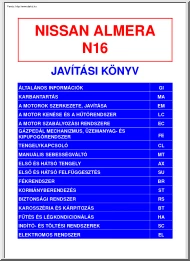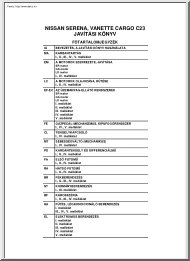Alapadatok
Év, oldalszám:2019, 5 oldal
Nyelv:angol
Letöltések száma:2
Feltöltve:2022. október 06.
Méret:1 MB
Intézmény:
-
Megjegyzés:
University of Brescia
Csatolmány:-
Letöltés PDF-ben:Kérlek jelentkezz be!
Értékelések
Nincs még értékelés. Legyél Te az első!Legnépszerűbb doksik ebben a kategóriában
Tartalmi kivonat
PATENT PENDING: GEAR SHIFT DEVICE OF A STEERING WHEEL GROUP PCT/IB2016/053816 published Jan 2017 PCT extension: application Nov 2017 National Patent 102015000028527, granted Dec 2017 https://patents.googlecom/patent/WO2017001994A1/en Contact Prof. Marco Gadola University of Brescia, Italy Dept. of Mechanical and Industrial Engineering Automotive Engineering & Design Group marco.gadola@unibsit Curriculum Vitae https://it.linkedincom/in/marcogadola Contents 1) Current scenario: standard gearshift paddles 2) The TACTILE GEARSHIFT concept: innovative, intuitive, involving 3) Additional possibilities for HMI 4) Figures Number of pages: 5 Via Branze 38 Brescia, 30-1-2019 25123 Brescia, Italy marco.gadola@unibsit www.unibsit https://it.linkedincom/in/marcogadola 1) Current scenario: standard gearshift paddles Passenger cars equipped with an automatic gearbox often feature the so-called “paddle shifters”, normally located ahead of the steering wheel. Such interface devices
are based on a pair of simple monostable switches. Usually the left-hand side paddle performs a downshift to the lower gear, and the right-hand side paddle upshifts to the taller gear. When in automatic mode, the driver can toggle one of the paddles with a fingertip to change gear manually and at the same time to select temporary manual gear shifting as an alternative mode. The purpose of the manual mode is twofold: on one side it is aimed at overriding the automatic gear change logics whenever this is perceived as not satisfactory or not suitable for a peculiar driving situation; on the other side, manual gear changing by means of the paddles can offer a sporty and satisfactory driving experience, that is perceived as more involving because powertrain control is put back into the driver’s hands – literally. The automatic gearbox offers comfort and relaxed driving, however it often makes the driver feel “disconnected” from the car. On the contrary manual gear shifting by means
of the paddles can restore the so-called “mechanical feeling” once upon a time experienced through the traditional gearstick lever. Driving enthusiasts in particular tend to consider manual shifting as a “pure” experience inspired by Formula 1 or Le Mans racing. A typical down side is that driving a car equipped with a 7-, 8- or even 9-gear automatic gearbox in full manual mode on the open road requires commitment: it can be demanding or even stressful. For this reason such cars usually feature the temporary manual gearshift mode as well, to be activated for a while by pressing one of the paddle shifters -hence also changing gear- once. While this is a driver’s deliberate action, the return back to automatic is managed by the gearbox logics as a function of vehicle motion -shifts are avoided while cornering or going down a steep descent for instance- and driver inputs. Usually the standard, fully automatic mode is restored after a few seconds of smooth driving (no sharp
acceleration, braking or steering, no more manual shiftings, and so on). Unfortunately the back-to-automatic, software-based transition is usually perceived as scarcely predictable and not intuitive, therefore originating an unpleasant perception of poor control. As a matter of fact quite a few patents focused on this transition strategy can be found, nevertheless press and internet often argue that the issue is yet unresolved. As a result the fully automatic mode is basically left active for the entire vehicle life while the temporary and full manual modes are very rarely used in real-life driving. 2) The TACTILE GEARSHIFT concept: innovative, intuitive, involving The so-called “Tactile gearshift” is a simple and effective idea aimed at overcoming this issue. It enables an innovative way to handle the transition between the fully automatic and temporary manual modes, even if the gearbox and interface hardware are basically unaltered. It has been 2/5 conceived for discerning
users that appreciate involved driving, probably as owners of a sportscar or a sporty family car. A touch-sensitive, capacitive surface is located on the gearshift paddles. Fingertip contact triggers an agile, transient changeover from automatic to manual, which does not require any gear shift to come into play. The manual mode is engaged as long as one of the fingertips is resting on a paddle The auto mode is restored as soon as contact is released (through a suitable transition strategy of course). The “Tactile gearshift” therefore can give birth to a smooth, “seamless” gearbox mode, enabling full control of the auto-manual transition and back, and restoring connection between driver and powertrain. The driver can control the gearbox directly and shift gear deliberately at any time without quitting the standard automatic mode: for example he can downshift gears as desired while braking into a tight corner, then let the gearbox perform the upshifts after the corner. Tests
carried out on our own professional driving simulator (a VI-grade unit) showed that interaction with the system is quite slick, intuitive and enjoyable. 3) Additional possibilities for HMI A smartphone-like vibration feedback can be adopted as a tactile or haptic response on the paddles. The touch surface could also be activated by means of double-tapping, flicking etc one of the paddles with one or more fingertips. This can be used for various other purposes, thus opening a scenario of unprecedented interactions with the car without removing the hands from the steering wheel. Advantages for active safety and for the driving experience from the feel/feedback point of view can be easily provided, such as: - “pre-selection” on a double-clutch gearbox - transition to sport mode/boost - start&stop control - “sailing mode” control - hybrid powertrain management - ADAS - etc The “touch” technology required under the form of a capacitive sensor is affordable and widely spread
in various markets, mainly the ICT and automotive sectors. A “force touch” proportional device could also be integrated in the paddles. This would open new scenarios where the gearshift action and velocity would perform according to the force applied by the driver, therefore recovering even more of the satisfactory feedback and control typical of oldstyle mechanical gearboxes with a clutch pedal and a lever stick. 3/5 4) Figures Tactile gearshift: main concept Prototype paddle shifters with touch-sensitive surfaces for driving simulator Haptic feedback through vibration 4/5 “Seamless mode” logics 5/5
are based on a pair of simple monostable switches. Usually the left-hand side paddle performs a downshift to the lower gear, and the right-hand side paddle upshifts to the taller gear. When in automatic mode, the driver can toggle one of the paddles with a fingertip to change gear manually and at the same time to select temporary manual gear shifting as an alternative mode. The purpose of the manual mode is twofold: on one side it is aimed at overriding the automatic gear change logics whenever this is perceived as not satisfactory or not suitable for a peculiar driving situation; on the other side, manual gear changing by means of the paddles can offer a sporty and satisfactory driving experience, that is perceived as more involving because powertrain control is put back into the driver’s hands – literally. The automatic gearbox offers comfort and relaxed driving, however it often makes the driver feel “disconnected” from the car. On the contrary manual gear shifting by means
of the paddles can restore the so-called “mechanical feeling” once upon a time experienced through the traditional gearstick lever. Driving enthusiasts in particular tend to consider manual shifting as a “pure” experience inspired by Formula 1 or Le Mans racing. A typical down side is that driving a car equipped with a 7-, 8- or even 9-gear automatic gearbox in full manual mode on the open road requires commitment: it can be demanding or even stressful. For this reason such cars usually feature the temporary manual gearshift mode as well, to be activated for a while by pressing one of the paddle shifters -hence also changing gear- once. While this is a driver’s deliberate action, the return back to automatic is managed by the gearbox logics as a function of vehicle motion -shifts are avoided while cornering or going down a steep descent for instance- and driver inputs. Usually the standard, fully automatic mode is restored after a few seconds of smooth driving (no sharp
acceleration, braking or steering, no more manual shiftings, and so on). Unfortunately the back-to-automatic, software-based transition is usually perceived as scarcely predictable and not intuitive, therefore originating an unpleasant perception of poor control. As a matter of fact quite a few patents focused on this transition strategy can be found, nevertheless press and internet often argue that the issue is yet unresolved. As a result the fully automatic mode is basically left active for the entire vehicle life while the temporary and full manual modes are very rarely used in real-life driving. 2) The TACTILE GEARSHIFT concept: innovative, intuitive, involving The so-called “Tactile gearshift” is a simple and effective idea aimed at overcoming this issue. It enables an innovative way to handle the transition between the fully automatic and temporary manual modes, even if the gearbox and interface hardware are basically unaltered. It has been 2/5 conceived for discerning
users that appreciate involved driving, probably as owners of a sportscar or a sporty family car. A touch-sensitive, capacitive surface is located on the gearshift paddles. Fingertip contact triggers an agile, transient changeover from automatic to manual, which does not require any gear shift to come into play. The manual mode is engaged as long as one of the fingertips is resting on a paddle The auto mode is restored as soon as contact is released (through a suitable transition strategy of course). The “Tactile gearshift” therefore can give birth to a smooth, “seamless” gearbox mode, enabling full control of the auto-manual transition and back, and restoring connection between driver and powertrain. The driver can control the gearbox directly and shift gear deliberately at any time without quitting the standard automatic mode: for example he can downshift gears as desired while braking into a tight corner, then let the gearbox perform the upshifts after the corner. Tests
carried out on our own professional driving simulator (a VI-grade unit) showed that interaction with the system is quite slick, intuitive and enjoyable. 3) Additional possibilities for HMI A smartphone-like vibration feedback can be adopted as a tactile or haptic response on the paddles. The touch surface could also be activated by means of double-tapping, flicking etc one of the paddles with one or more fingertips. This can be used for various other purposes, thus opening a scenario of unprecedented interactions with the car without removing the hands from the steering wheel. Advantages for active safety and for the driving experience from the feel/feedback point of view can be easily provided, such as: - “pre-selection” on a double-clutch gearbox - transition to sport mode/boost - start&stop control - “sailing mode” control - hybrid powertrain management - ADAS - etc The “touch” technology required under the form of a capacitive sensor is affordable and widely spread
in various markets, mainly the ICT and automotive sectors. A “force touch” proportional device could also be integrated in the paddles. This would open new scenarios where the gearshift action and velocity would perform according to the force applied by the driver, therefore recovering even more of the satisfactory feedback and control typical of oldstyle mechanical gearboxes with a clutch pedal and a lever stick. 3/5 4) Figures Tactile gearshift: main concept Prototype paddle shifters with touch-sensitive surfaces for driving simulator Haptic feedback through vibration 4/5 “Seamless mode” logics 5/5





